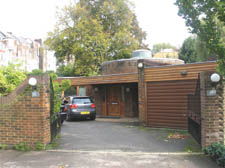|
|
 |
| |

The unlisted house in Frognal Way built in the 1970s and saved – for now – from the wrecker’s ball |
A 70s home that is worth conserving...
and that’s partly because of the unusual artist architect who designed it,
writes Dan Carrier
NUMBER 22 Frognal Way in Hampstead has had the wrecker’s ball hanging over it for more than a year: its owners applied to pull down the current home and replace it with two town houses.
To some, the brown-glazed bricks and varnished wooden door look dated. The house was built in the early 1970s, and has the hallmarks of the trends of the period.
But for the time being it will remain: Camden Council rejected the application, and last week the Department of the Environment threw out an appeal to overturn the decision.
It is, according to conservation group The Twentieth Century Society and English Heritage, a classic piece of modern design and should be recognised as such.
Frognal Way was once part of the fields that made up the Frognal estate, and was sold off in plots – giving the new owners plenty of scope to commission an architect to create something unique.
Pre-war British modernist Maxwell Fry built his famous Sun House at the start of the road, followed by Arts & Crafts homes. Then there is an artist’s studio, designed by CHB Quennell for a professor at the Slade, tucked alongside 1940s singer Gracie Fields’ symmetrical, green-tiled home. And to its left of the plot is number 22, designed by Kentish Town architect Philip Pank.
Pank, who died in 1991, ran a small practice in Torriano Cottages and, according to the planning inspector who gave his Frognal Way house a stay of execution last week, “... is of interesting and distinctive design and appearance, designed by an architect of some local importance. It continues and adds to the theme of individual houses in Frognal Way, which define its character.”
Born in India in 1933, Philip was the son of a doctor. He had always wanted to be an artist but his father was keen for him to take up a profession. He chose architecture – believing it would offer a similar challenge to his creativity.
He would attend life classes at St Martins and the Royal Academy every week, and did so right up to his death.
“He would always take a two-week holiday and paint every day,” recalls his wife Tricia. “So he was putting in the same hours as a full-time artist would, as well as working as an architect.”
His influences in design were the 20th-century architects who had inspired his generation – Le Corbusier, Frank Lloyd Wright.
As for painters, it was always about brightness. “He loved Cezanne and Matisse,” said Tricia. “For him, they were the masters of colour.”
In the early 1970s, he was commissioned to build a wheelchair-friendly house. He drew up plans for a central living space with rooms jutting out into the garden, which could easily be accessed.
It is one of few examples of his work that dot Camden. As well as Frognal Way, he built a two-storey house in Millfield Lane, overlooking the Highgate ponds. His work can also be found in Daleham Gardens, Hampstead, and he was responsible for extensions across the Kentish Town and Dartmouth Park area.
Tricia, who lives in the home he built in Torriano Cottages, recalls his respect for the space his homes were to fill.
“The planners had suggested a typical front and back garden, but it would mean cutting down an elm tree on the site,” she says. “Philip would have none of it and instead designed the home with a central courtyard to allow the tree to be saved.”
And while “green” roofs are in vogue now, 40 years ago Philip designed a roof garden for his home, complete with lawn and pond.
Architect Alan Power, who oversaw the new designs for Frognal Way, said he was disappointed. “We do not look at this with a cavalier eye,” he said. “We consulted widely and spoke to conservation area experts. Nobody got close to saying there may be difficulties in not retaining this building.”
Philip’s Frognal home has been saved – for the time being. It is not listed, and a new application could come in. If successful it would mean the loss of a classic example of a talented Camden designer’s work.
|

|
 |
|
 |
|

